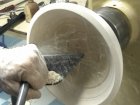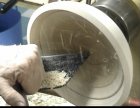No matter what I do I seem to get chatter marks when I’m hollowing out dry bowls. Green bowls no problem. Outside profile no problem. Inside is where I get problems.
Today was some bone dry milo, from Hawaii. 12”x5” with the rim at about 3/8”. Freshly sharpened 1/2” dway gouge off a 600grit CBN wheel. 40/40 grind. 800ish rpm. 100mm tenon perfectly sized for my chuck jaws and Well seated. PM3520 lathe. I’ve left ‘meat’ inside the bowl to support the rim. A careful slow 1/16” final pass and I still get this the attached results.
The same tool left a flawless finish on the outside of the bowl.
Now- the plus side- it looks way worse in the photo than it was. I couldn’t feel the marks at all and right after I took the photo a few seconds with 180grit abranet with the lathe running and the marks are gone. So maybe I’m fretting over nothing. I’m definitely sanding less these days than I used to but I’d like to get the best cut off the tool possible.
I’ve tried different grinds. I’ve tried my Thompson gouges. I’ve tried supporting the outside rim with my hand.
Thoughts?
Today was some bone dry milo, from Hawaii. 12”x5” with the rim at about 3/8”. Freshly sharpened 1/2” dway gouge off a 600grit CBN wheel. 40/40 grind. 800ish rpm. 100mm tenon perfectly sized for my chuck jaws and Well seated. PM3520 lathe. I’ve left ‘meat’ inside the bowl to support the rim. A careful slow 1/16” final pass and I still get this the attached results.
The same tool left a flawless finish on the outside of the bowl.
Now- the plus side- it looks way worse in the photo than it was. I couldn’t feel the marks at all and right after I took the photo a few seconds with 180grit abranet with the lathe running and the marks are gone. So maybe I’m fretting over nothing. I’m definitely sanding less these days than I used to but I’d like to get the best cut off the tool possible.
I’ve tried different grinds. I’ve tried my Thompson gouges. I’ve tried supporting the outside rim with my hand.
Thoughts?




